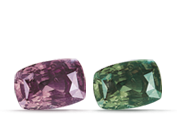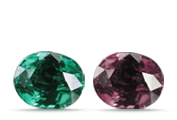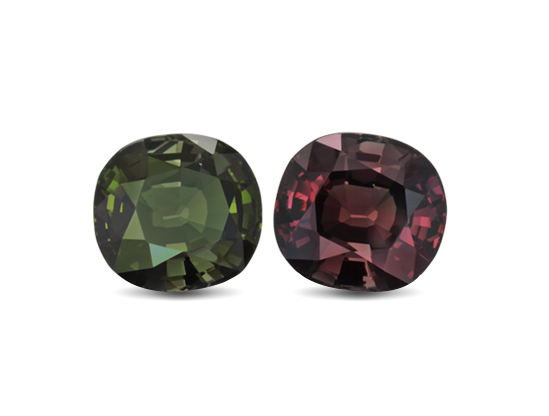ALEXANDRITE
ALEXANDRITE Green in sunlight. Red in lamplight. Color-changing alexandrite is nature’s magic trick.
OVERVIEW
ABOUT ALEXANDRITE
Often described by gem aficionados as “emerald by day, ruby by night,” alexandrite is the very rare color-change variety of the mineral chrysoberyl. Originally discovered in Russia’s Ural Mountains in the 1830s, it’s now found in Sri Lanka, East Africa, and Brazil, but fine material is exceptionally rare and valuable.
BIRTHSTONES & ANNIVERSARIES
Alexandrite is a birthstone for June, along with pearl and moonstone. Alexandrite is also the gem for the 55th wedding anniversary.
1830
The year alexandrite was discovered in Russia’s Ural Mountains.
CZAR ALEXANDER II
Gem’s namesake who emancipated Russia’s serfs and was assassinated in 1881.
580NM
This absorption band allows alexandrite to shift from red to green when viewed under different light sources.
FACTS
Mineral: Chrysoberyl
Chemistry: BeAl2O4
Color: Bluish green in daylight, purplish red in incandescent light
Refractive Index: 1.746 to 1.755
Birefringence: 0.008 to 0.010
Specific Gravity: 3.73
Mohs Hardness: 8.5
WHY WE LOVE THIS GEMSTONE
1 COLOR CHANGE
Making alexandrite change color from green to red is the world’s most fun use of a penlight.
2 LIGHT SOURCE
This gem provides dramatic proof of how much the light source affects color in gems.
3 PHENOMENA
Alexandrite can show both color change and a cat’s-eye: two phenomena in one gem.
QUALITY FACTORS
COLOR

Fine alexandrite is green to bluish green in daylight and red to purplish red in incandescent light.
CLARITY

Good quality alexandrite has few inclusions. Rarely, needle-like inclusions create a cat’s-eye.
CUT

Alexandrite is most often available in mixed cuts. Its rarity means it is often cut to save weight.
CARAT WEIGHT

Most cut gems weigh less than one carat. Larger, higher-quality gems rise in price dramatically.

